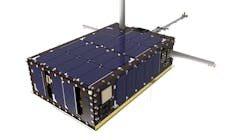NASA surveys industry for atmospheric monitoring CubeSat that will push the bounds of SWaP in spacecraft
HAMPTON, Va. – U.S. space researchers are surveying industry for companies able to build a small constellation of orbiting CubeSat satellites, each about the size of a shoebox, to monitor aerosols, ozone, and other components of the Earth's atmosphere.
Officials of the National Aeronautics and Space Administration (NASA) Langley Research Center in Hampton, Va., issued a sources-sought notice (SS_SAGEIV_PDO) on Friday for the Small Satellite Technologies atmospheric monitoring/measurement concept(s) project.
NASA wants capabilities and ideas from industry to help design an integrated CubeSat spacecraft and Stratospheric Aerosol and Gas Experiment (SAGE) IV sensor to monitor Earth's atmosphere as part of Earth Venture system science projects. The integrated spacecraft and sensor should measure about 14.2 inches by 4.8 inches and weigh no more than 26.5 pounds.
The SAGE IV project will capitalize on new small satellite technologies to design a new CubeSat sensor to match or exceed capabilities of the SAGE III sensor payload, which measures about 3.8 cubic feet, weighs about 725 pounds, and operates from the International Space Station.
NASA experts want to design the SAGE IV in a 6U CubeSat form factor, and deploy it in a constellation of four or more SAGE IV CubeSats for continuous monitoring of atmospheric aerosols, ozone, and other atmospheric components.
The SAGE IV project seeks to observe the sun during sunrise and sunset in spectral channels that range between the ultraviolet and infrared. This sources-sought notice seeks out vendors that can provide the necessary detector; spacecraft bus; and assembly, integration, and testing (AI&T) services.
The SAGE IV sensor will require a commercial off-the-shelf (COTS) space-quality 2D PIN diode array with square pixels that should not exceed 35-micron pitch; have active area no smaller than 4 by 4 millimeters; and offer a total focal plane assembly package size no larger than 50 by 48 by 20 millimeters.
The project seeks full potential well density of 5000 electrons per square micron; spectral sensitivity between 350 and 1050 nanometers; programmable integration time enabling stepping of between 5 and 20 milliseconds; at least 12-bit readout electronics; and full-frame readout rate of at least 20 Hz.
Related: DARPA wants real-time CubeSat communications to link micro-satellite constellations
The project will require either an integrated active thermal control system or available surface area on the back side of the focal plane assembly for government bonding of a government-supplied thermoelectric cooler system.
The SAGE IV project will require space-quality CubeSat or small satellite spacecraft buses including structures and trusses for a likely 6U form factor equipped with a solar panel electrical power system with more than 75 Watts of power available to the instrument.
Companies interested in making their capabilities known to NASA should email capabilities statements no later than 19 Nov. 2019 to NASA's Ceseley Dunbar at [email protected].
Email questions or concerns to NASA's Michael Obland at [email protected]. More information is online at https://www.fbo.gov/spg/NASA/LaRC/OPDC20220/SS_SAGEIV_PDO/listing.html.
About the Author
John Keller
Editor-in-Chief
John Keller is the Editor-in-Chief, Military & Aerospace Electronics Magazine--provides extensive coverage and analysis of enabling electronics and optoelectronic technologies in military, space and commercial aviation applications. John has been a member of the Military & Aerospace Electronics staff since 1989 and chief editor since 1995.
